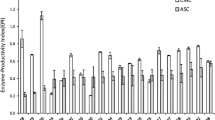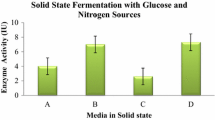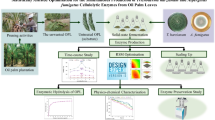Abstract
The major constraint in the enzymatic saccharification of biomass for ethanol production is the cost of cellulase enzymes. Production cost of cellulases may be brought down by multifaceted approaches which includes the use of cheap lignocellulosic substrates for fermentation production of the enzyme, and the use of cost efficient fermentation strategies like solid state fermentation (SSF). The current study investigated the production of cellulase by Trichoderma reesei RUT C30 on wheat bran under SSF. Process parameters important in cellulase production were identified by a Plackett and Burman design and the parameters with significant effects on enzyme production were optimized for maximal yield using a central composite rotary design (CCD). Higher initial moisture content of the medium had a negative effect on production whereas incubation temperature influenced cellulase production positively in the tested range. Optimization of the levels of incubation temperature and initial moisture content of the medium resulted in a 6.2 fold increase in production from 0.605 to 3.8 U/gds of cellulase. The optimal combination of moisture and temperature was found to be 37.56% and 30 °C, respectively, for maximal cellulase production by the fungus on wheat bran.
Similar content being viewed by others
References
van Zessen, E., Weismann, M., Bakker, R. R., Elberson, H. W., Reith, J. H., & den Uil, H. (2003). Lignocellulosic ethanol—A second opinion. NAEE Netherlands. Online—May 2003. [Cited 12 May 2006]. Available from http://www.novem.nl/default.asp?menuId=10&documentId=34649.
Wang, M., Saricks, C., & Santini, D. (1999). Effects of fuel ethanol use on fuel-cycle energy and greenhouse gas emissions. Report of the Argonne National Laboratory, Centre for Transportation Research, No: ANL/ESD-38, Jan. 1999. NTIS, US Dept of Commerce, Springfield, VA.
Kamm, B., & Kamm, M. (2004). Biorefinery—systems. Chemical and Biochemical Engineering Quarterly, 18, 1–6.
Knauf, M., & Moniruzzaman, M. (2004). Lignocellulosic biomass processing: A perspective. International Sugar Journal, 106, 147–150.
Gregg, D. J., Boussaid, A., & Saddler, J. N. (1998). Techno-economic evaluation of a generic wood-to-ethanol process: Effect of increased cellulose yields and enzyme recycle. Bioresource Technology, 63, 7–12.
Chahal, P. S., Chahal, D. S., & Andre, G. (1992). Cellulase production profile of Trichoderma reesei on different cellulosic substrates at various pH levels. Journal of Fermentation and Bioengineering, 74, 126–128.
Reczey, K., Szengyel, Z., Eklund, R., & Zacchi, G. (1996). Cellulase production by T. reesei. Bioresource Technology, 57, 25–30.
Doppelbauer, R., Esterbauer, H., Steiner, W., Lafferty, R., & Steinmuller, H. (1987). The use of cellulosic wastes for production of cellulases by Trichoderma reesei. Applied Microbiology and Biotechnology, 26, 485–494.
Duff, S. J. B., & Murray, W. D. (1996). Bioconversion of forest products industry waste cellulosics to fuel ethanol: A review. Bioresource Technology, 55, 1–33.
Adsul, M. G., Ghule, J. E., Singh, R., Shaikh, H., Bastawdea, K. B., Gokhale, D. V., et al. (2004). Polysaccharides from bagasse: Applications in cellulase and xylanase production. Carbohydrate Polymers, 57, 67–72.
Vandevoorde, L., & Verstraete, W. (1987). Anaerobic solid state fermentation of cellulosic substrates with possible application to cellulase production. Applied Microbiology and Biotechnology, 26, 479–484.
Reimbault, M. (1998). General and microbiological aspects of solid substrate fermentation. Electronic Journal of Biotechnology (Online)—Issue of 15 Dec 1998. [Cited 12 May 2006] Available from http://www.ejbiotechnology.info/content/vol1/issue3/full/9/index.html. ISSN 0717-3458.
Gutierrez-Correa, M., Portala, L., Moreno, P., & Tengerdy, R. P. (1999). Mixed culture solid substrate fermentation of Trichoderma reesei with Aspergillus niger on sugar cane bagasse. Bioresource Technology, 68, 173–178.
Chahal, D. S. (1985). Solid-state fermentation with Trichoderma reesei for cellulase production. Applied and Environmental Microbiology, 49, 205–210.
Tengerdy, R. P. (1996). Cellulase production by solid state fermentation. Journal of Scientific and Industrial Research, 55, 313–316.
Nigam, P., & Singh, D. (1996). Processing of agricultural wastes in solid state fermentation for cellulolytic enzyme production. Journal of Scientific and Industrial Research, 55, 457–467.
Plackett, R. L., & Burman, J. P. (1946). The design of optimum multi-factorial experiments. Biometrika, 33, 305–325.
Box, G. E. P., & Wilson, K. B. (1951). On the experimental attainment of optimum conditions. Journal of the Royal Statistical Society. Series B. Methodological, 13, 1–45.
Pandey, A., Soccol, C. R., & Mitchell, D. (2000). New developments in solid state fermentation: I bioprocesses and products. Process Biochemistry, 35, 1153–1169.
Oriol, E., Raimbault, M., Roussos, S., & Viniegra-Gonzales, G. (1988). Water and water activity in the solid state fermentation of cassava starch by Aspergillus niger. Applied Microbiology and Biotechnology, 27, 498–503.
Nakari-Setala, T., & Pentilla, M. (1995). Production of Trichoderma reesei cellulases on glucose-containing media. Applied and Environmental Microbiology, 61, 3650–3655.
Ilmen, M., Saloheimo, A., Onnela, M. L., & Penttila, M. E. (1997). Regulation of cellulase gene expression in the filamentous fungus Trichoderma reesei. Applied and Environmental Microbiology, 63, 1298–1306.
Wen, Z., Liao, W., & Chen, S. (2005). Production of cellulase by Trichoderma reesei from dairy manure. Bioresource Technology, 96, 491–499.
Author information
Authors and Affiliations
Corresponding author
Rights and permissions
About this article
Cite this article
Singhania, R.R., Sukumaran, R.K. & Pandey, A. Improved Cellulase Production by Trichoderma reesei RUT C30 under SSF Through Process Optimization. Appl Biochem Biotechnol 142, 60–70 (2007). https://doi.org/10.1007/s12010-007-0019-2
Received:
Revised:
Accepted:
Published:
Issue Date:
DOI: https://doi.org/10.1007/s12010-007-0019-2




